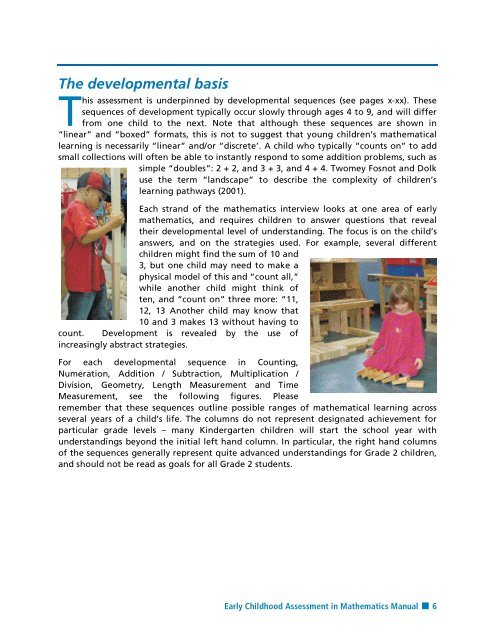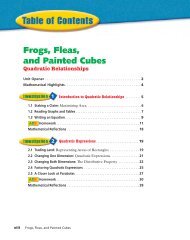ECAM-Manual-and-Resources
ECAM-Manual-and-Resources
ECAM-Manual-and-Resources
You also want an ePaper? Increase the reach of your titles
YUMPU automatically turns print PDFs into web optimized ePapers that Google loves.
The developmental basis<br />
T<br />
his assessment is underpinned by developmental sequences (see pages x-xx). These<br />
sequences of development typically occur slowly through ages 4 to 9, <strong>and</strong> will differ<br />
from one child to the next. Note that although these sequences are shown in<br />
“linear” <strong>and</strong> “boxed” formats, this is not to suggest that young children’s mathematical<br />
learning is necessarily “linear” <strong>and</strong>/or “discrete’. A child who typically “counts on” to add<br />
small collections will often be able to instantly respond to some addition problems, such as<br />
simple “doubles”: 2 + 2, <strong>and</strong> 3 + 3, <strong>and</strong> 4 + 4. Twomey Fosnot <strong>and</strong> Dolk<br />
use the term “l<strong>and</strong>scape” to describe the complexity of children’s<br />
learning pathways (2001).<br />
Each str<strong>and</strong> of the mathematics interview looks at one area of early<br />
mathematics, <strong>and</strong> requires children to answer questions that reveal<br />
their developmental level of underst<strong>and</strong>ing. The focus is on the child’s<br />
answers, <strong>and</strong> on the strategies used. For example, several different<br />
children might find the sum of 10 <strong>and</strong><br />
3, but one child may need to make a<br />
physical model of this <strong>and</strong> “count all,”<br />
while another child might think of<br />
ten, <strong>and</strong> “count on” three more: “11,<br />
12, 13 Another child may know that<br />
10 <strong>and</strong> 3 makes 13 without having to<br />
count. Development is revealed by the use of<br />
increasingly abstract strategies.<br />
For each developmental sequence in Counting,<br />
Numeration, Addition / Subtraction, Multiplication /<br />
Division, Geometry, Length Measurement <strong>and</strong> Time<br />
Measurement, see the following figures. Please<br />
remember that these sequences outline possible ranges of mathematical learning across<br />
several years of a child’s life. The columns do not represent designated achievement for<br />
particular grade levels – many Kindergarten children will start the school year with<br />
underst<strong>and</strong>ings beyond the initial left h<strong>and</strong> column. In particular, the right h<strong>and</strong> columns<br />
of the sequences generally represent quite advanced underst<strong>and</strong>ings for Grade 2 children,<br />
<strong>and</strong> should not be read as goals for all Grade 2 students.<br />
Early Childhood Assessment in Mathematics <strong>Manual</strong> ■ 6



